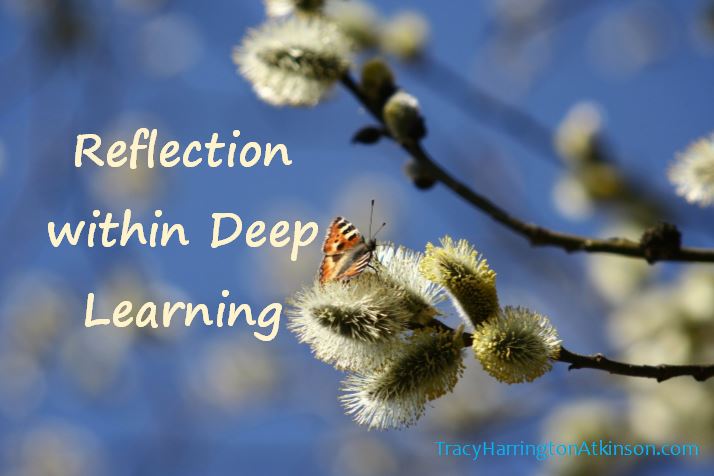 Reflective practice allows professionals to identify areas of needs and while developing strategies built upon documented knowledge and information. “It is a way of thinking that fosters personal learning, behavioral change, and improved performance” (Ostermann & Kottkamp, 2004, p. 1) which is completed through a systematic approach of learning and changing. It is a practice which promotes questioning, analyzing existing behaviors and theories, encourages learning while also expressing the need for individuals and organizations to ponder. Such pondering moments allow progress to incur beyond a simple trial and error method (York-Barr et al., 2005).
Reflective practice allows professionals to identify areas of needs and while developing strategies built upon documented knowledge and information. “It is a way of thinking that fosters personal learning, behavioral change, and improved performance” (Ostermann & Kottkamp, 2004, p. 1) which is completed through a systematic approach of learning and changing. It is a practice which promotes questioning, analyzing existing behaviors and theories, encourages learning while also expressing the need for individuals and organizations to ponder. Such pondering moments allow progress to incur beyond a simple trial and error method (York-Barr et al., 2005).
Reflective practice progresses through several steps. The practitioner first identifies a problem followed by the observation and analysis stage. Ostermann & Kottkamp (2004) identify this stage as “the most critical and complex of the four” (p. 28) stages. This stage entails the necessity of not only gathering information about the problem without tainting it with personal judgment but also analyzing the dilemma as it is compared from the current situation to the desired goal. The third stage, abstract reconceptualization requires the practitioner to investigate new solutions and resources which address the root of the dilemma. Lastly, experimentation enters as the new strategies are utilized in changing behaviors. York-Barr et al. (2005) suggests that these steps are not linear, nor are they circular. Each step is interconnected with the others.
The study skills sheet in the above figure illustrates this process visually, guiding the individual through the reflection of an experience. Using these questions helps to develop the conclusions and observations. However, the greatest option is to modify the process to best meet your individual needs.
Although criticizing is not encouraged during the recording process of a learning journal. It is emphasized and promoted during the reflection process. Be sure to criticize experiences, notes, information and new knowledge during this phase. Evaluate the importance of the information and critically review the relevance.
One Minute Reflection
This is one of my favorite methods of reflecting on an event. I cannot recall where I learned about it. I’ve simply been doing it for as long as I can remember.
Recording information can seem overwhelming, especially when encountering the numerous experiences throughout a day. I have found by setting a timer (usually on my cellphone) for one minute I can record a few thoughts. This helps me to not forget what I learned. It also helps me to recall later even the feelings, emotions and other thoughts associated with the experience.
As I stated before, including a little extra space on the page provides an opportunity to revisit experiences and information later. This way when the one minute is completed, there is still space for another opportunity to approach the experience. Many times, I’ve found I will have additional insights later in the day or even days later.
Record Impressions
One of the purposes of learning journal is to create a place for reflection, giving space to reflect on the learning process. It can provide a venue for this process and even remind an individual to reflect on learning simply from having a learning journal nearby. Reflection and recording impressions are associated with a deeper learning, meta-cognition.
Where to gather information, the process of recording it and reflecting on entries are all part of the how to keep a learning journal. Although each of these steps are vital in my learning journal process, but I highly encourage individuals to mold the process to their needs. Make it personal. By personalizing the process, the probably of continuing to use a learning journal will be increased.
By Tracy Atkinson
 Tracy Atkinson, mother of six, lives in the Midwest with her husband and spirited long-haired miniature dachshunds. She is a teacher, having taught elementary school to higher education, holding degrees in elementary education and a master’s in higher education. Her passion is teaching, researching, studying and enjoying time with her family. She has published several titles, including MBTI Learning Styles: A Practical Approach. Courses available on learning styles and student success at: Udemy, Teachable or Thinkific.
Tracy Atkinson, mother of six, lives in the Midwest with her husband and spirited long-haired miniature dachshunds. She is a teacher, having taught elementary school to higher education, holding degrees in elementary education and a master’s in higher education. Her passion is teaching, researching, studying and enjoying time with her family. She has published several titles, including MBTI Learning Styles: A Practical Approach. Courses available on learning styles and student success at: Udemy, Teachable or Thinkific.

Comments are closed